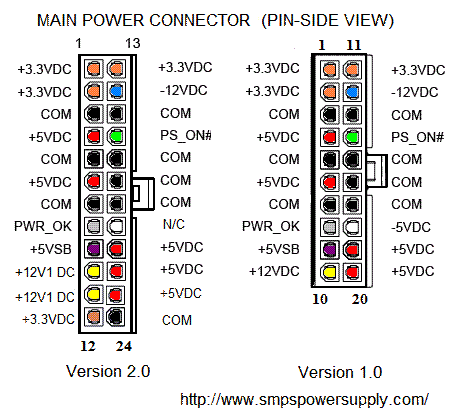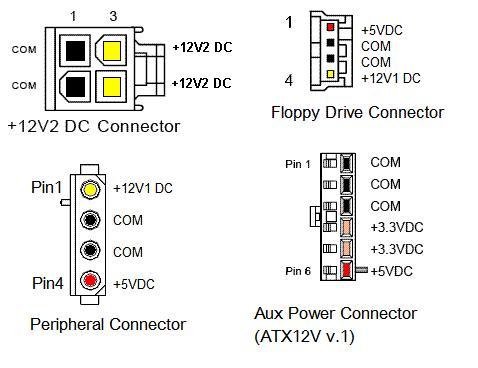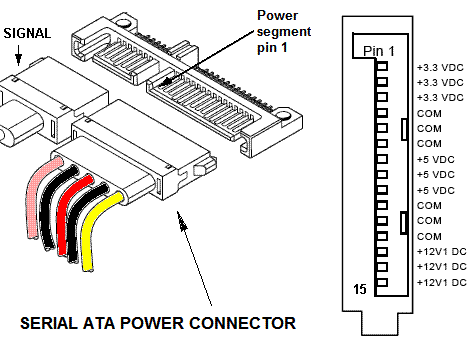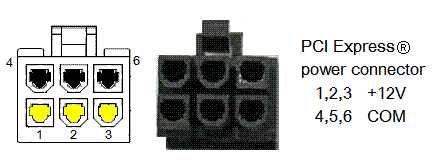COMPUTER POWER SUPPLY: PINOUT, CABLES, CONNECTORS
| Home | Reference | ATX3 pinout | Magnetic Units | SMPS Tutorial |
| Color Codes | Metric Conversion | Computer PSU | Calculators | ATX pinout |
Computer power supply units (PSU) deliver the power to the PC hardware via a number of cables with connectors. Their generic specifications for various desktop systems are defined in Intel's PSU design guides. Intel periodically revises their guides, but the core information used to remain the same. Previous standard casually called ATX2 was released in 2003. Its last revision v2.52 was released on June 2018. This guide combined the requirements for ATX12V and its five variations. In 2022 Intel released new ATX 3.0 standard with a brand new auxiliary power connector 12VHPWR. Note that some brand name manufacturers did not follow Intel guidelines and used non-standard pinouts. You can fry your board if you mix and match ATX and branded parts. Also see the information on a single-rail ATX12VO standard and pinout of RJ45 connectors in PoE systems.
Standard ATX power supplies typically have the main power connector P1, additional 12V connectors, as well as peripheral, floppy drive, serial ATA, and PCI Express® receptacles, which we will describe below.
For the operation basics of SMPS PSU see our power supply tutorial. The original ATX systems had 20-pin main connector P1. When PCI Express® bus was introduced, PCIe cards needed up to 75W extra. To provide the additional wattage, the old part has been replaced by a new 24-pin P1. Accordingly, different ATX-style PSU may use different number of power wires: see the pinout diagram to the right. The colors in this chart represent recommended wire colors in the PSU cables. These diagrams reflect the front view. The colors are shown here just for reference (you won't see them from the front).
The P1 uses Molex Housing Mini-Fit Jr. P/N# 39-01-2240 style (old part number was 5557-24R), contacts: 44476-1112. Mating motherboard header is Molex 44206-0007. The old socket was 39-01-2200 and the mating header was 39-29-9202. People often want to know what to do if there is a mismatch. Well, under certain conditions a new PSU can still be used with an old PC and vise versa- see our guide on connecting 20-pin PSU to 24-pin motherboard. That said, if you have such an old unit, most likely its electrolytic capacitors dried out, so it's not worth working with it.
If you want to do some testing of a stand alone unit, to start it up outside of a PC case you need to short PS_ON# line to the common. Otherwise, only 5V standby voltage will be present.
Under normal operation, PS_ON# is activated by motherboard when you press and release the computer power button while it is in standby mode. Some Apple models have this signal reversed.

Also note that some brands such as Apple's Power Mac, Dell (during certain years), Compaq and HP used proprietary boards with entirely different pin designations- see this for info on some brand name power supplies.
All voltages are referenced to the same common (if you need to measure any voltage, connect the return lead of your voltmeter to any of the COM contacts).
The rated current of the main Molex connector is 6A per contact. This means with the old 20-pin style you can't get more than 18A from 3.3V and 24A from 5V. That's why in early 2000's, some motherboards with 3.3V >18A and 5V >24A (mainly dual CPU AMD systems) used an auxiliary 6-pin power cable. It was removed from ATX12V spec v2.0 in 2003 because extra wires were added to P1. For more information on form factors see our computer PSU tutorial.
When the industry began using voltage regulation modules (VRM) running off 12V2 to energize CPU and other motherboard components, the bulk of the wattage shifted to 12 volt bus. Most of today's motherboards supply their CPU with a separate 12 volt cable, which has 4 pins for ATX style (sometimes called P4) or 8 or more pins for EPS and non-standard high-power systems. Some PSUs may have three or four 12 volt 4-pin connectors. The p/n for a standard P4 is 39-01-2040 or equivalent.
Peripheral power connector goes to disk drives, cooling fans, and other smaller devices. A very old model may also have a floppy drive cable.
Note that the wire numbers in Serial Power ATA (SATA) connector are not 1:1. There are three pins for each voltage. One pin from each voltage is used for pre-charge in the backplane. The mating serial plug of ATA devices contains both signal and power segments.
Some units may also have an optional 2x3 socket that can be used for auxiliary functions, such as fan monitoring and control, IEEE-1394 power source, and a remote sense of 3.3 V.
PSU over 450W designed for high-end discrete graphics cards normally have additional 2x3 or 2x4 connectors. They supply extra current to graphics that require more than 75 watts total.
The 6-pin PCI Express® receptacle is Molex p/n 0455590002.
If you want all essential information on power supply design (topologies, equations, magnetics, etc.) get my SMPS reference.
Standard ATX power supplies typically have the main power connector P1, additional 12V connectors, as well as peripheral, floppy drive, serial ATA, and PCI Express® receptacles, which we will describe below.
For the operation basics of SMPS PSU see our power supply tutorial. The original ATX systems had 20-pin main connector P1. When PCI Express® bus was introduced, PCIe cards needed up to 75W extra. To provide the additional wattage, the old part has been replaced by a new 24-pin P1. Accordingly, different ATX-style PSU may use different number of power wires: see the pinout diagram to the right. The colors in this chart represent recommended wire colors in the PSU cables. These diagrams reflect the front view. The colors are shown here just for reference (you won't see them from the front).
The P1 uses Molex Housing Mini-Fit Jr. P/N# 39-01-2240 style (old part number was 5557-24R), contacts: 44476-1112. Mating motherboard header is Molex 44206-0007. The old socket was 39-01-2200 and the mating header was 39-29-9202. People often want to know what to do if there is a mismatch. Well, under certain conditions a new PSU can still be used with an old PC and vise versa- see our guide on connecting 20-pin PSU to 24-pin motherboard. That said, if you have such an old unit, most likely its electrolytic capacitors dried out, so it's not worth working with it.
If you want to do some testing of a stand alone unit, to start it up outside of a PC case you need to short PS_ON# line to the common. Otherwise, only 5V standby voltage will be present.
Also note that some brands such as Apple's Power Mac, Dell (during certain years), Compaq and HP used proprietary boards with entirely different pin designations- see this for info on some brand name power supplies.
All voltages are referenced to the same common (if you need to measure any voltage, connect the return lead of your voltmeter to any of the COM contacts).
The rated current of the main Molex connector is 6A per contact. This means with the old 20-pin style you can't get more than 18A from 3.3V and 24A from 5V. That's why in early 2000's, some motherboards with 3.3V >18A and 5V >24A (mainly dual CPU AMD systems) used an auxiliary 6-pin power cable. It was removed from ATX12V spec v2.0 in 2003 because extra wires were added to P1. For more information on form factors see our computer PSU tutorial.
When the industry began using voltage regulation modules (VRM) running off 12V2 to energize CPU and other motherboard components, the bulk of the wattage shifted to 12 volt bus. Most of today's motherboards supply their CPU with a separate 12 volt cable, which has 4 pins for ATX style (sometimes called P4) or 8 or more pins for EPS and non-standard high-power systems. Some PSUs may have three or four 12 volt 4-pin connectors. The p/n for a standard P4 is 39-01-2040 or equivalent.
Peripheral power connector goes to disk drives, cooling fans, and other smaller devices. A very old model may also have a floppy drive cable.
Note that the wire numbers in Serial Power ATA (SATA) connector are not 1:1. There are three pins for each voltage. One pin from each voltage is used for pre-charge in the backplane. The mating serial plug of ATA devices contains both signal and power segments.
Some units may also have an optional 2x3 socket that can be used for auxiliary functions, such as fan monitoring and control, IEEE-1394 power source, and a remote sense of 3.3 V.
PSU over 450W designed for high-end discrete graphics cards normally have additional 2x3 or 2x4 connectors. They supply extra current to graphics that require more than 75 watts total.
The 6-pin PCI Express® receptacle is Molex p/n 0455590002.
If you want all essential information on power supply design (topologies, equations, magnetics, etc.) get my SMPS reference.